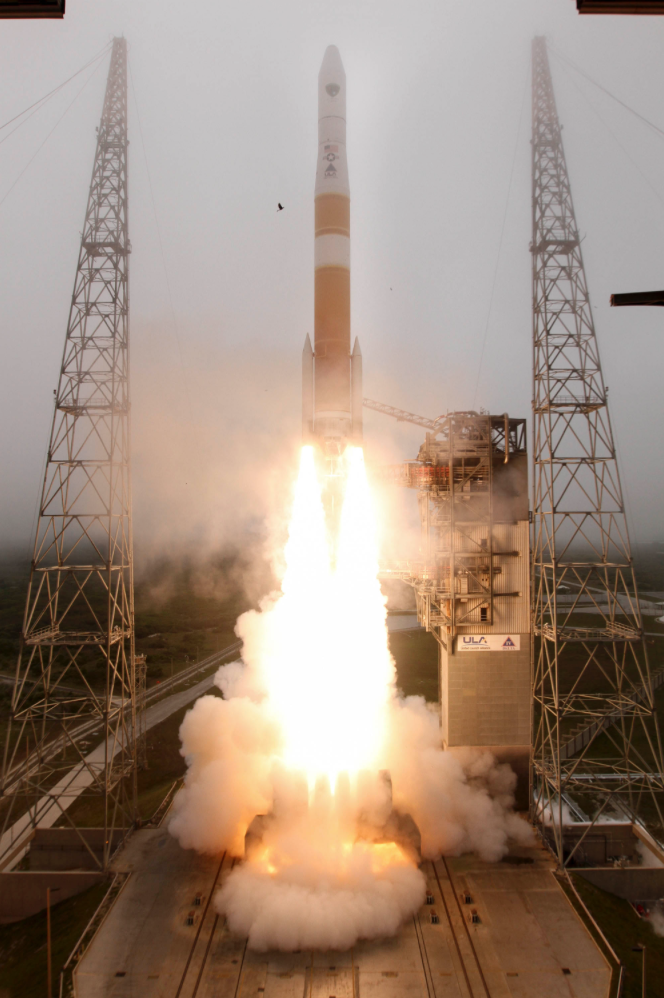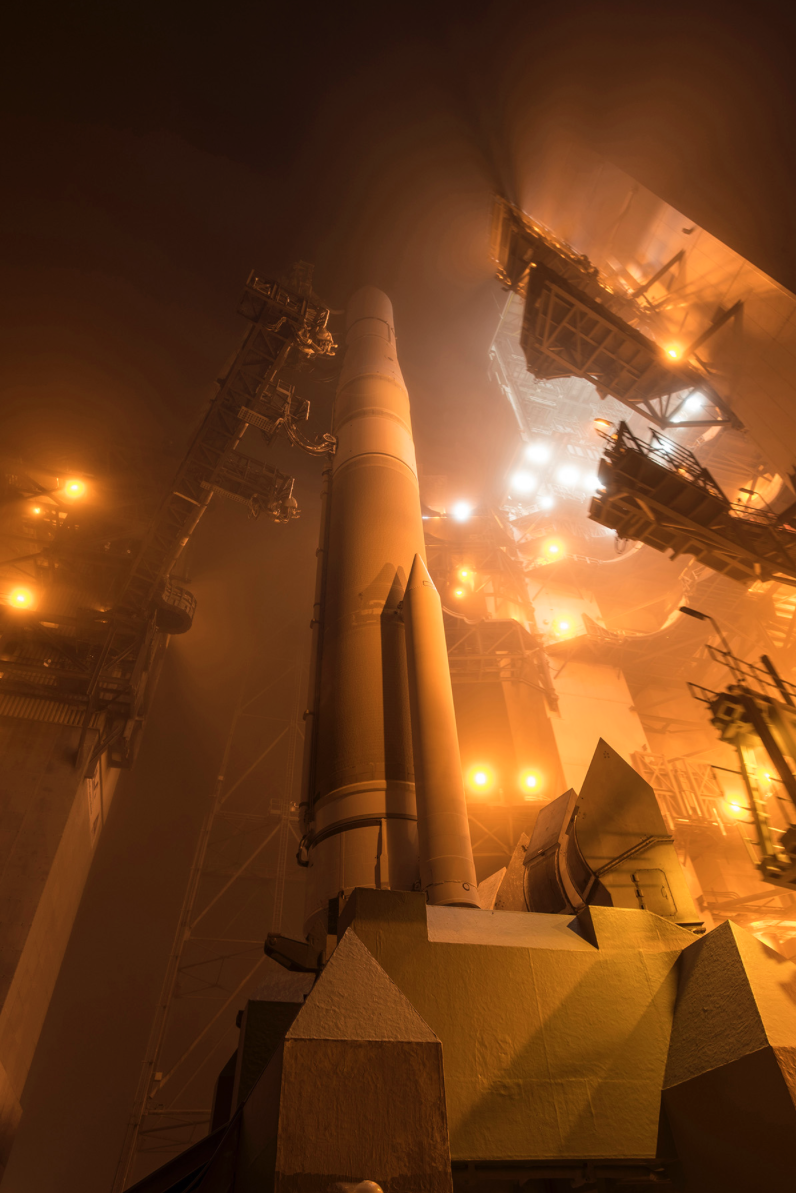
Cape Canaveral Air Force Station, Florida. (March 25, 2015) A United Launch Alliance (ULA) Delta IV rocket successfully launched the ninth Global Positioning System (GPS) IIF satellite for the U.S. Air Force at 2:36 p.m. EDT today from Space Launch Complex-37. This is ULA’s fourth launch in 2015 and the 95th successful launch since the company was formed in December 2006.
[SatNews] Fog didn't dampen the spirits of those involved in a successful launch today of the GPS IIF-9 launch for the United States Air Force. The mission liftoff was 2:36 p.m. EDT on a ULA Delta IV rocket from Space Launch Complex 37 at Cape Canaveral Air Force Station in Florida.
Official Statement From United Launch Alliance
Cape Canaveral Air Force Station, Fla., (March 25, 2015) – A United Launch Alliance (ULA) Delta IV rocket successfully launched the ninth Global Positioning System (GPS) IIF satellite for the U.S. Air Force at 2:36 p.m. EDT today from Space Launch Complex-37. This is ULA’s fourth launch in 2015 and the 95th successful launch since the company was formed in December 2006.
“Congratulations to the Air Force and all of our mission partners on today’s successful launch of GPS IIF-9! The ULA team is privileged to work with this world-class U.S. government and contractor mission team, and we are proud to contribute to the GPS capabilities that were delivered to orbit today,” said Jim Sponnick, ULA vice president, Atlas and Delta Programs.“This entire team is focused on 100 percent mission success, one launch at a time, and also providing on-time launches to meet our customer’s mission needs.”
This mission was launched aboard a Delta IV Medium-plus (4,2) configuration Evolved Expendable Launch Vehicle (EELV) using a single ULA common booster core powered by an Aerojet Rocketdyne RS-68 main engine, along with two Orbital ATK GEM-60 solid rocket motors. The upper stage was powered by an Aerojet Rocketdyne RL10B-2 engine with the satellite encapsulated in a four-meter-diameter composite payload fairing.
GPS IIF-9 is the ninth in a series of next generation GPS satellites and will join the GPS worldwide timing and navigation system utilizing 24 satellites in six different planes, with a minimum of four satellites per plane positioned in orbit approximately 11,000 miles above the Earth’s surface. The GPS IIF series provides improved accuracy and enhanced performance for GPS users.
ULA's next launch is the Atlas V AFSPC-5 mission for the United States Air Force, scheduled for May 6 from Space Launch Complex-41 from Cape Canaveral Air Force Station, Florida.
The EELV program was established by the United States Air Force to provide assured access to space for Department of Defense and other government payloads. The commercially developed EELV program supports the full range of government mission requirements, while delivering on schedule and providing significant cost savings over the heritage launch systems.

Cape Canaveral Air Force Station, Fla. (March 25, 2015) - A United Launch Alliance Delta IV rocket stands ready for launch at Space Launch Complex-37 with the GPS IIF-9 payload. Launch is scheduled for this afternoon at 2:36 p.m. EDT. GPS IIF-9 is the ninth in a series of next generation GPS satellites and will join a worldwide timing and navigation system utilizing 24 satellites in six different planes, with a minimum of four satellites per plane positioned in orbit approximately 11,000 miles above the Earth’s surface.
Photo: United Launch Alliance
With more than a century of combined heritage, United Launch Alliance is the nation’s most experienced and reliable launch service provider. ULA has successfully delivered more than 90 satellites to orbit that provide critical capabilities for troops in the field, aid meteorologists in tracking severe weather, enable personal device-based GPS navigation and unlock the mysteries of our solar system.
For more information on ULA, visit the ULA website at www.ulalaunch.com, or call the ULA Launch Hotline at 1-877-ULA-4321 (852-4321). Join the conversation at www.facebook.com/ulalaunch, twitter.com/ulalaunch and instagram.com/ulalaunch.
End Of United Launch Alliance Statement
Mission Description: GPS satellites serve and protect our warfighters by providing navigational assistance for U.S. military operations on land, at sea, and in the air. Civilian users around the world also use and depend on GPS for highly accurate time, location, and velocity information.
GPS IIF-9 is one of the next-generation GPS satellites, incorporating various improvements to provide greater accuracy, increased signals, and enhanced performance for users.
A United Launch Alliance Delta IV Medium+ (4,2) will deliver the GPS IIF-9 satellite to semi-synchronous circular orbit. Liftoff will occur from Space Launch Complex 37 at Cape Canaveral Air Force Station, Florida.
The Navstar Global Positioning System (GPS) is a constellation of satellites that provides navigation data to military and civilian users worldwide. The system is operated and controlled by the 50th Space Wing, located at Schriever Air Force Base, Colorado.
Jim Sponnick, VP, Atlas and Delta Programs said, "The ULA team is proud to be the launch provider for the U.S. Air Force (USAF) Global Positioning System (GPS) Directorate by delivering replenishment satellites aboard Atlas V and Delta IV launch vehicles. GPS IIF-9 is one of the next generation GPS satellites, incorporating various improvements to provide greater accuracy, increased signals, and enhanced performance for users."
GPS utilizes 24 satellites, in six different planes, with a minimum of four satellites per plane, positioned in orbit approximately 11,000 miles above the Earth’s surface. The satellites continuously transmit digital radio signals pertaining to the exact time (using atomic clocks) and exact location of the satellites. The GPS IIF series have a design life of 12 years. With the proper equipment, users can receive these signals to calculate time, location, and velocity. The signals are so accurate that time can be measured to within a millionth of a second, velocity within a fraction of a mile per hour, and location to within feet. Receivers have been developed for use in aircraft, ships, land vehicles, and to hand carry.
The ULA team is focused on attaining Perfect Product Delivery for the GPS IIF-9 mission, which includes a relentless focus on mission suc- cess (the perfect product) and also excellence and continuous improvement in meeting all of the needs of our customers (the perfect delivery).
As a result of increased civil and commercial use as well as experience in military operations, the USAF has added the following capabilities and technologies to the GPS IIF series to sustain the space and control segments while improving mission performance:
- Two times greater predicted signal accuracy than heritage satellites.
- New L5 signals for more robust civil and commercial aviation.
- An on-orbit, reprogrammable processor, receiving software uploads for improved system operation.
- Military signal “M-code” and variable power for better resistance to jamming hostile environments, meeting the needs of emerging doctrines of navigation warfare